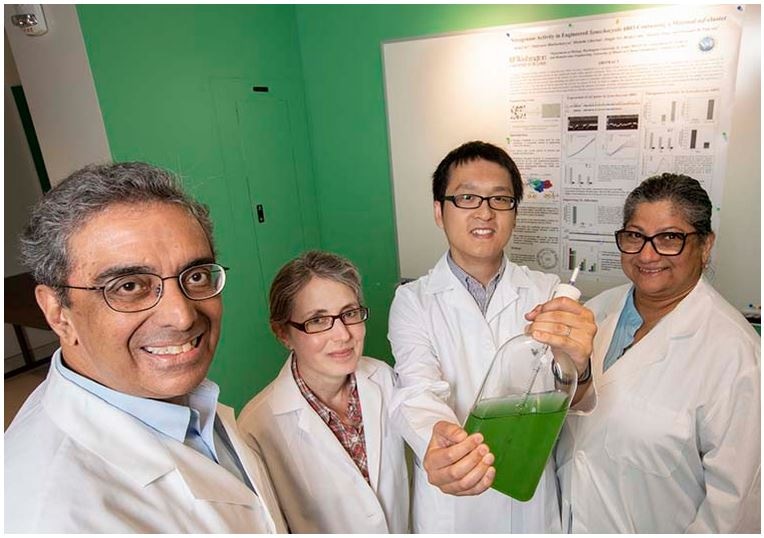Jul 17 2018
Plants will be able to produce their own fertilizer in the future meaning farmers will not have to purchase and spread fertilizers for their crops anymore. The resulting increase in food production will also benefit countless numbers of people across the globe, who would otherwie go hungry.
 The team included Himadri Pakrasi (left), Michelle Liberton (second from left), Deng Liu and Maitrayee Bhattacharyya-Pakrasi. (Image Credit: Joe Angeles/Washington University)
The team included Himadri Pakrasi (left), Michelle Liberton (second from left), Deng Liu and Maitrayee Bhattacharyya-Pakrasi. (Image Credit: Joe Angeles/Washington University)
While statements like these may sound more like something out of a science fiction novel, a new study performed by scientists in Washington University in St. Louis demonstrates that plants could possibly be engineered to develop their own fertilizer. This latest finding could have a major impact on agriculture and the planet’s health.
The study was headed by Himadri Pakrasi, the Glassberg-Greensfelder Distinguished University Professor in the Department of Biology in Arts & Sciences and director of the International Center for Energy, Environment and Sustainability (InCEES); and Maitrayee Bhattacharyya-Pakrasi, senior research associate in biology. It was reported in the May/June issue of mBio.
It is energy intensive to create fertilizers and during this process, greenhouse gases are produced that are a key driver of climate change. The process is also inefficient.
Fertilizing is a kind of delivery system for nitrogen, which is used by plants to produce chlorophyll for photosynthesis. However, just less than 40% of the nitrogen in commercial fertilizer reaches the plant.
Once a plant has been fertilized, runoff is yet another issue. Fertilizer that is washed away by rain ends up in lakes, rivers, streams, and bays, feeding algae that may grow out of control, obstructing sunlight, and destroy animal and plant life underneath.
Conversely, another abundant source of nitrogen exists around us. The atmosphere of the Ear this roughly made up of 78% nitrogen, and the Pakrasi laboratory in the Department of Biology recently designed a bacterium that can utilize that atmospheric gas through a process called “fixing” nitrogen in a major step toward producing plants that can perform the same.
The study was based on the fact that, while plants do not have the ability to fix nitrogen from the air, a subset of cyanobacteria exists that is able to do so.
Cyanobacteria are organisms that photosynthesize like plants. These bacteria are able to do this, although oxygen interferes with the nitrogen fixation process.
Cyanothece, the bacteria employed in this analysis, is capable of fixing nitrogen because it shares one common thing with people.
“Cyanobacteria are the only bacteria that have a circadian rhythm,” said Pakrasi. Remarkably, these bacteria photosynthesize during the day time, changing sunlight to the chemical energy they utilize as fuel, and fix nitrogen at night time, after removing most of the oxygen produced during photosynthesis via respiration.
The researchers wanted to remove the genes—responsible for this day-night mechanism—from Cyanothece, and put them into Synechocystis, which is another type of cyanobacteria, to make this organism to also fix nitrogen from the air.
In order to locate the right sequence of genes, the researchers searched for the significant circadian rhythm.
We saw a contiguous set of 35 genes that were doing things only at night, and they were basically silent during the day.”
Professor Himadri Pakrasi
The research group, which also included former research associate Jingjie Yu, research associate Michelle Liberton, and Deng Liu added the genes from Cyanothece after manually removing the oxygen from Synechocystis.
The team observed that Synechocystis was capable of fixing nitrogen at 2% of Cyanothece. However, when the postdoctoral researcher Liu, who has been the backbone of the project, started to remove some of those genes, things became really interesting; Synechocystis, with only 24 of the Cyanothece genes, was able to fix nitrogen at a speed of over 30% of Cyanothece.
When a small amount of oxygen (up to 1%) was added, nitrogen fixation rates reduced significantly but when a different group of genes from Cyanothece was added, the rates increased again, although rates as high as without the presence of oxygen were not reached.
For the team, the next steps are to look deeper into the process details, possibly further narrow down the subset of genes required for nitrogen fixation, and partner with other plant researchers to apply the lessons gained from this analysis to the next level, i.e. nitrogen-fixing plants.
According to the World Bank, crops that utilize atmospheric nitrogen will be most effective for subsistence farmers — approximately 800 million people globally— increasing yields on a scale that is advantageous to a town or a family as well as freeing up time that was once spent physically to spread fertilizers.
If it’s a success, it will be a significant change in agriculture.”
Bhattacharyya-Pakrasi